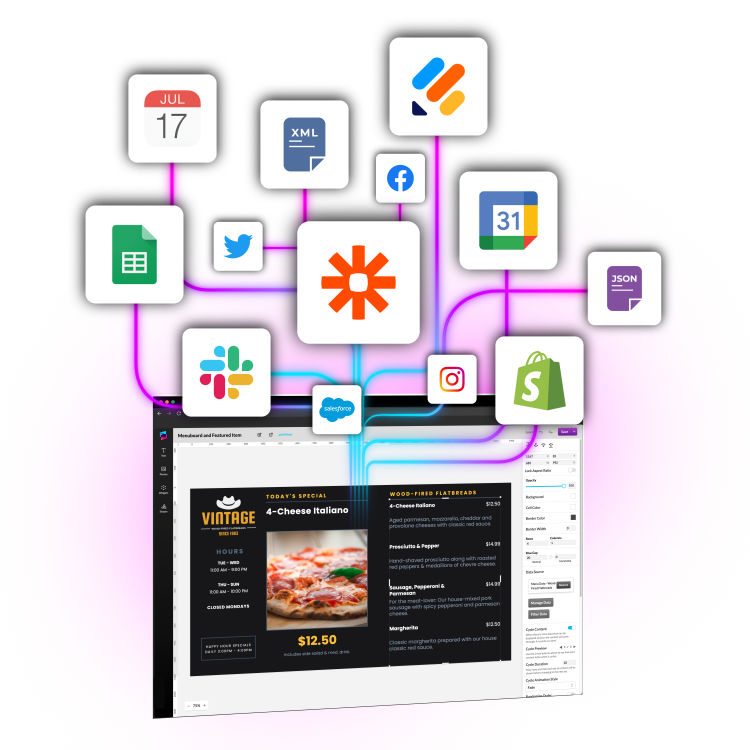
Screenfeed Goes No Code With New Connect Dynamic Messaging Toolset
June 7, 2022 by Dave Haynes
The Minneapolis-based subscription content company Screenfeed has launched a new content creation toolset that applies the concept of no-code software to producing customized, data-driven and fully automated messaging for digital signage networks.
Called Screenfeed Connect, and the product of 30,000 developer hours over the last two years, the essence of the platform is making it both possible and affordable to design, integrate and publish dynamic messaging that taps into data sources and updates without any operator intervention.
Screenfeed has been doing subscription content feeds like weather, news and sports for more than a decade, but the difference here is how this is for whatever information needs to get automatically pushed to screens as conditions change. For example, if a manufacturer wants to visualize KPIs from a production line on screens around the workfloor, Connect can be used to pull the data sources, layout, timing and other parameters together.
That’s normally done by software firms and solutions providers as custom development work that can tend to take a lot of time and money. A lot of ideas and needs never happen because the budget, time or skills aren’t there.
With no code, the tools are in place to put HTML5-based automated messaging pieces together that update as the sourced data changes.
Screenfeed explains it this way:
Traditionally, custom HTML content powered by your own data has been great in theory, but difficult in practice. You’d be hard pressed to find any one person able to build dynamic content from scratch, make the design easy on the eyes, build data integration into the content, and, finally, keep it fresh at a consistent rate. Managing projects like these represents a big project or saying ‘no’ for those that don’t have the team, resources or bandwidth.
That’s why we built Connect: to come in and take care of the developing, designing, and data connecting needed to allow dynamic messaging to be displayed on screens. The only steps of content app creation you have to think about are choosing a template, uploading a data source, and getting a URL to schedule right into your software, all from Connect.
Data integration into content apps means it’s now possible to display teams, progress towards goals, leaderboards, dynamic pricing, menu changes on menu boards, wayfinding with directories, and any other important moments or promotions for your business via digital signage content. Easily integrate with favorites you already know and use now: Google sheets and calendar, Excel, Zapier, JSON, and XML data (plus more on the way later!) all work in Connect.

Our team has done the heavy lifting so you’re empowered to get the most value from your network with the least amount of effort required.
This is just the beginning too! As time goes on, Connect will be built out even further: in fact, we’re already geared for another round of Connect enhancements with more templates, data integrations, and features, right after launch and beyond. We can’t wait for you to try it out.
Screenfeed founder Jeremy Gavin contacted me last week to give me a head’s up on Connect. He has a team down in Las Vegas at InfoComm and the product will be demo’d at the company’s booth, in the digital signage zone (north hall).
I recorded a chat about Connect and that will be up overnight as a podcast.
Screenfeed is a big sponsor of Sixteen:Nine and the podcast, but I’d be writing and talking about this anyway. Many software companies have some degree of content authoring tools and templates to help screen network operators more easily update messaging. But this is a couple of steps, at least, beyond that.
It is similar to the approach Intuiface has taken with no code for interactive displays.
All but the most basic screen networks can benefit from messaging that ties into other information systems, so that whatever is on screens is both timely and relevant, without requiring operators to get involved in the updates. Done well, you set these sorts of things and forget them.
Data messaging produced in Connect works very much like the feeds Screenfeed produces, so if a network operator or solutions provider already uses Screenfeed, this will work, as well. The HTML5 outputs will work on any typical CMS.



Leave a comment